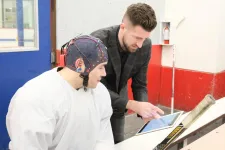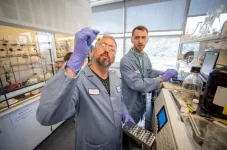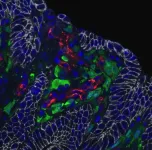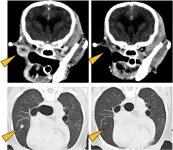(Press-News.org) Surrey, B.C. Canada and Rochester, Minn., U.S. (April 22, 2021) - Neuroscience researchers at Mayo Clinic Orthopedics and Sports Medicine in Rochester, Minnesota, U.S., the Health and Technology District and Simon Fraser University (SFU) in Surrey, British Columbia, Canada have published the latest results of their ongoing multi-year hockey concussion study examining changes in subconcussive cognitive brain function in male youth ice hockey players.
The research team monitored brain vital signs during pre- and post-season play in 23 Bantam (age 14 or under) and Junior A (age 16 to 20) male ice-hockey players in Rochester, Minnesota.
"Brain vital signs" translates complex brain waves measured using portable electroencephalography (EEG) at the rink-side, into simple, fast, user-friendly and intuitive results that provide an objective evaluation of cognitive brain function. Called the ABCs of brain function, brain vital signs track three well-established neural responses for Auditory sensation (using a response called the N100), Basic attention (using a response called the P300), and Cognitive processing (using a response called the N400).
The study builds on 2019 results published in Brain: A Journal of Neurology that confirmed significant brain vitals sign changes shortly after concussions were diagnosed in Junior A players. Key results of this study showed undetected impairments remained when players were cleared to return to play using current clinical concussion protocols. Notably, the initial study also reported sensitivity to subconcussive impairments in those players who did not sustain a concussion diagnosis over the course of the season.
The current second phase of the study replicated these results and added the Bantam age group. The latest findings were recently published in the peer-reviewed journal Brain Communications in the advanced articles section.
The results of this new Brain Communications study showed:
Significant brain vital sign changes in N100 Auditory sensation and N400 Cognitive processing responses for the pre-to-post season comparison across both groups.
Differences between the Bantam and Junior A ice hockey players showed more changes in the Junior A group.
Importantly, the subconcussive changes were significantly correlated with the number of head impacts over the season across both age groups and consequently showed more subconcussive changes in brain vital signs.
A subconcussive impact is a mechanical force transmitted to the brain below the threshold for a diagnosis of an acute concussive injury. The effects of these low-magnitude impacts may not even be noticeable to the player or to observers on the sideline. Head impacts in the sport of ice hockey typically result from player-to-player or player-to-boards contact due to body checking, collisions and fighting . Some of these impacts are the consequence of foul play, but many of these events also result from routine, legal on-ice behavior.
"Concussion in sports is a major concern for many and our research has shown that having an objective physiological measure of brain function at rink-side is key to detection and managing concussive impacts," says Dr. Aynsley Smith, principal investigator of the study and Associate Professor of Orthopedics at Mayo Clinic in Rochester, Minnesota.
The study, funded in part by USA Hockey, was co-led by Dr. Michael Stuart, Professor of Orthopedics at Mayo Clinic in Rochester, Minnesota. It is also part of a larger concussion research team within Mayo Clinic that includes neurology research leadership from Dr. David Dodick, Professor of Neurology at Mayo Clinic in Phoenix, Arizona, U.S.
Canadian collaborators include neuroscientist Dr. Ryan D'Arcy, an SFU professor and co-founder of the Health and Technology District in Surrey B.C. and Dr. Shaun Fickling, a biomedical engineer, a recent SFU PhD graduate and lead author of the study.
"Our research has shown that repetitive subconcussive impacts triggered compounding effects in brain function changes, which underscores the importance of shifting our thinking and understanding of concussions as a singular acute-injury model to a spectrum of head-impact exposure and effects over time," says Dr. Fickling.
The US-Canadian concussion research team is continuing to advance their collaborative effort.
Says Dr. D'Arcy, "In medicine: you can't treat what you can't measure. With breakthroughs on measurement challenges, we hope to now accelerate treatment innovations for prevention, acute care and extended care concussion management - for all people across a range of different applications. Our partnership is moving into incredibly exciting future steps - stay tuned."
INFORMATION:
The research study was designed and carried out by the Mayo Clinic Sports Medicine Ice Hockey Research team, partially funded by USA Hockey Foundation and the Johannson-Gund Endowment. Financial support was also provided by the Mathematics of Information Technology and Complex Systems (MITACS), Natural Sciences and Engineering Council Canada (NSERC) and the Canadian Institutes for Health Research (CIHR).
About Mayo Clinic:
Mayo Clinic is a nonprofit organization committed to innovation in clinical practice, education and research, and providing compassion, expertise and answers to everyone who needs healing. Visit the Mayo Clinic News Network for additional Mayo Clinic news. For information on COVID-19, including Mayo Clinic's Coronavirus Map tracking tool, which has 14-day forecasting on COVID-19 trends, visit the Mayo Clinic COVID-19 Resource Center.
About Simon Fraser University (SFU):
As Canada's engaged university, SFU works with communities, organizations and partners to create, share and embrace knowledge that improves life and generates real change. We deliver a world-class education with lifelong value that shapes change-makers, visionaries and problem-solvers. We connect research and innovation to entrepreneurship and industry to deliver sustainable, relevant solutions to today's problems. With campuses in British Columbia's three largest cities--Vancouver, Burnaby and Surrey--SFU has eight faculties that deliver 193 undergraduate degree programs and 127 graduate degree programs to more than 37,000 students. The university now boasts more than 165,000 alumni residing in 143 countries. http://www.sfu.ca
About Health and Technology District:
The Health and Technology District in Surrey, B.C., is a rapidly expanding ecosystem of innovators and entrepreneurs collaborating with tech companies, scientists, educators and health professionals; each representing a range of business, technologies and research fields. The series of high-tech buildings located and under expansion strategically across from Surrey Memorial Hospital, offers a dynamic community where disruptive impacts are generated through the translation of research, science and technology into global innovations. Within this, the current research is a result of the BrainNET initiative to translate neuroscience knowledge directly into clinical advances in care. http://www.HealthandTechnologyDistrict.com
Media contact: Yvonne Chiang, news@chiangpr.ca
Plastics are a part of nearly every product we use on a daily basis. The average person in the U.S. generates about 100 kg of plastic waste per year, most of which goes straight to a landfill. A team led by Corinne Scown, Brett Helms, Jay Keasling, and Kristin Persson at Lawrence Berkeley National Laboratory (Berkeley Lab) set out to change that.
Less than two years ago, Helms announced the invention of a new plastic that could tackle the waste crisis head on. Called poly(diketoenamine), or PDK, the material has all the convenient properties of traditional plastics while avoiding the environmental pitfalls, because unlike traditional plastics, PDKs can be recycled indefinitely ...
Living away from community and country, Aboriginal families of children with severe burns also face critical financial stress to cover the associated costs of health care and treatment, a new study shows.
An Australian study, led by Flinders researchers Dr Courtney Ryder and Associate Professor Tamara Mackean, found feelings of crisis were common in Aboriginal families with children suffering severe burns, with one family reporting skipping meals and others selling assets to reduce costs while in hospital.
The economic hardship was found to be worse in families who live in rural areas - some households travelling more ...
Rising levels of dementia is putting pressure on residential aged care facilities, including in rural and regional centres where nursing homes and staff are already under pressure.
Now a pilot program of personalised interventions, including residents' favourite songs, has been shown to make a big difference to dementia behaviours, drug use and carers' wellbeing.
Harmony in the Bush, a study led by Flinders University in five nursing homes in Queensland and South Australia, developed a multimodal person-centred non-pharmacological intervention program incorporating ...
A new molecular 'freeze frame' technique has allowed WEHI researchers to see key steps in how the protein MLKL kills cells.
Small proteins called 'monobodies' were used to freeze MLKL at different stages as it moved from a dormant to an activated state, a key process that enables an inflammatory form of cell death called necroptosis. The team were able to map how the three-dimensional structure of MLKL changed, revealing potential target sites that might be targets for drugs - a potential new approach to blocking necroptosis as a treatment for inflammatory diseases.
The research, which ...
IL-11 is known to promote the development of colorectal cancer in humans and mice, but when and where IL-11 is expressed during cancer development is unknown. "To address these questions experimentally, we generated reporter mice that express the green fluorescent protein (EGFP) gene in interleukin 11 (IL-11)-producing (IL11+) cells in vivo. We found IL-11+ cells in the colons of this murine colitis-associated colorectal cancer model," said Dr. Nishina, the lead author of a study published April 16 in Nature Communications. "The IL-11+ cells were absent from the colon under normal conditions but rapidly appeared in the tissues of mice with colitis and colorectal cancer."
In the study, Dr. Nishina and colleagues characterized the IL-11+ cells by flow cytometry and found that ...
The human immune defense is based on the ability of white blood cells to accurately identify disease-causing pathogens and to initiate a defense reaction against them. The immune defense is able to recall the pathogens it has encountered previously, on which, for example, the effectiveness of vaccines is based. Thus, the immune defense the most accurate patient record system that carries a history of all pathogens an individual has faced. This information however has previously been difficult to obtain from patient samples.
The learning immune system can be roughly divided into two parts, of which B cells are responsible for producing antibodies against pathogens, while T cells are responsible for destroying their targets. The measurement of antibodies by traditional laboratory ...
The study was published by the team from Ruhr-Universität Bochum (RUB), the Max Planck Institutes of Biochemistry and Biophysics, the Center for Synthetic Microbiology (SYNMIKRO) and the Chemistry Department at Philipps Universität Marburg, the University of Illinois Urbana-Champaign, USA, and Université Paris-Saclay, France, online on 12 April 2021 in the journal Nature Plants.
Catalyst of life
Photosystem II (PS II) is of fundamental importance for life, as it is able to catalyse the splitting of water. The oxygen released in this reaction allows us to breathe. In addition, PS II converts light energy ...
Scientists have shown that the biological molecule PD-L1 is a potential target for the treatment of metastasized oral malignant melanoma in dogs.
There are a number of cancers that affect dogs, but there are far fewer diagnosis and treatment options for these canine cancers. However, as dogs and humans are both mammals, it is likely that strategies and treatments for cancers in humans can be used for canine cancer, with minor modifications.
A team of scientists, including Associate Professor Satoru Konnai from the Faculty of Veterinary Medicine at Hokkaido University, have demonstrated that an anti-cancer therapy that targets the cancer marker PD-L1--a target that has shown great promise for treating cancer in humans--is ...
Notch proteins are key regulators of growth and differentiation of both normal and cancer cells. Researchers in Turku, Finland, have now demonstrated that the activities of distinct Notch family members are modified differently by phosphorylation. These results can be used in the development of new cancer treatments, especially for hormone-dependent breast cancer.
Breast cancer is the most common type of cancer in women in Finland and other Western countries. Due to the availability of hormonal therapies, the estrogen-responsive breast cancer cases have a relatively good prognosis as compared to other breast cancer subtypes. However, some of them can also develop into an aggressive, metastatic disease, for which new types ...
New research by the University of New England's Palaeoscience Research Centre suggests juvenile tyrannosaurs were slenderer and relatively faster for their body size compared to their multi-tonne parents.
The research, published in the END ...





